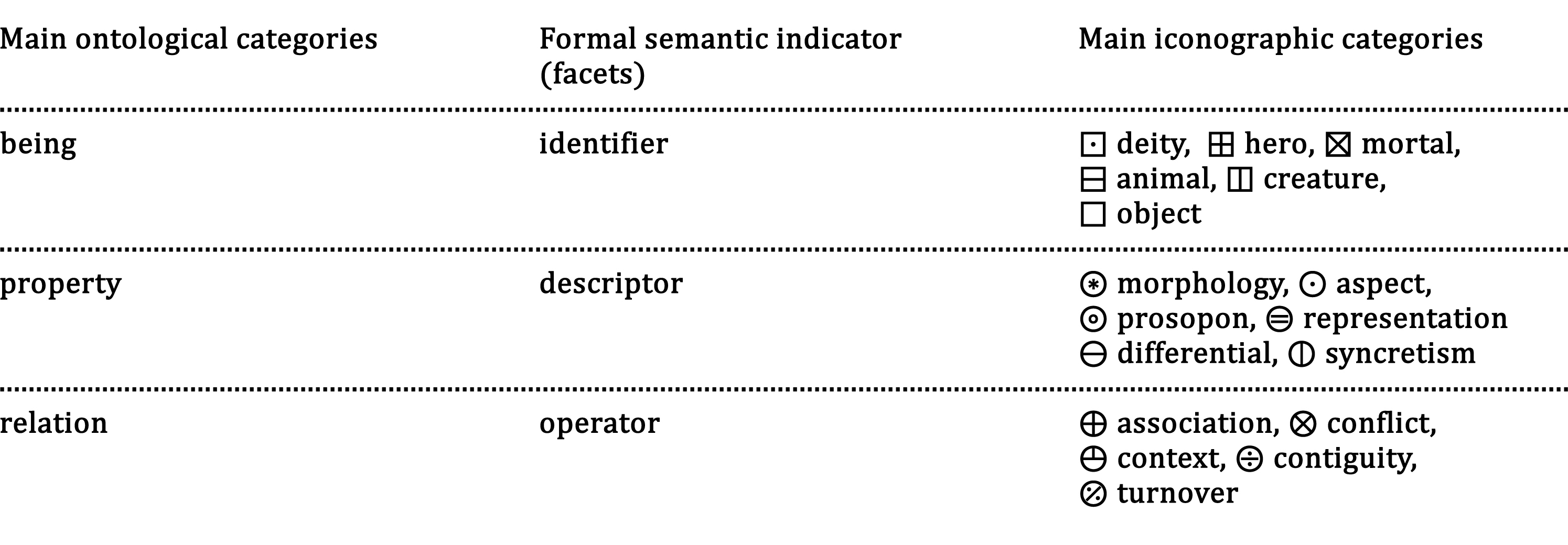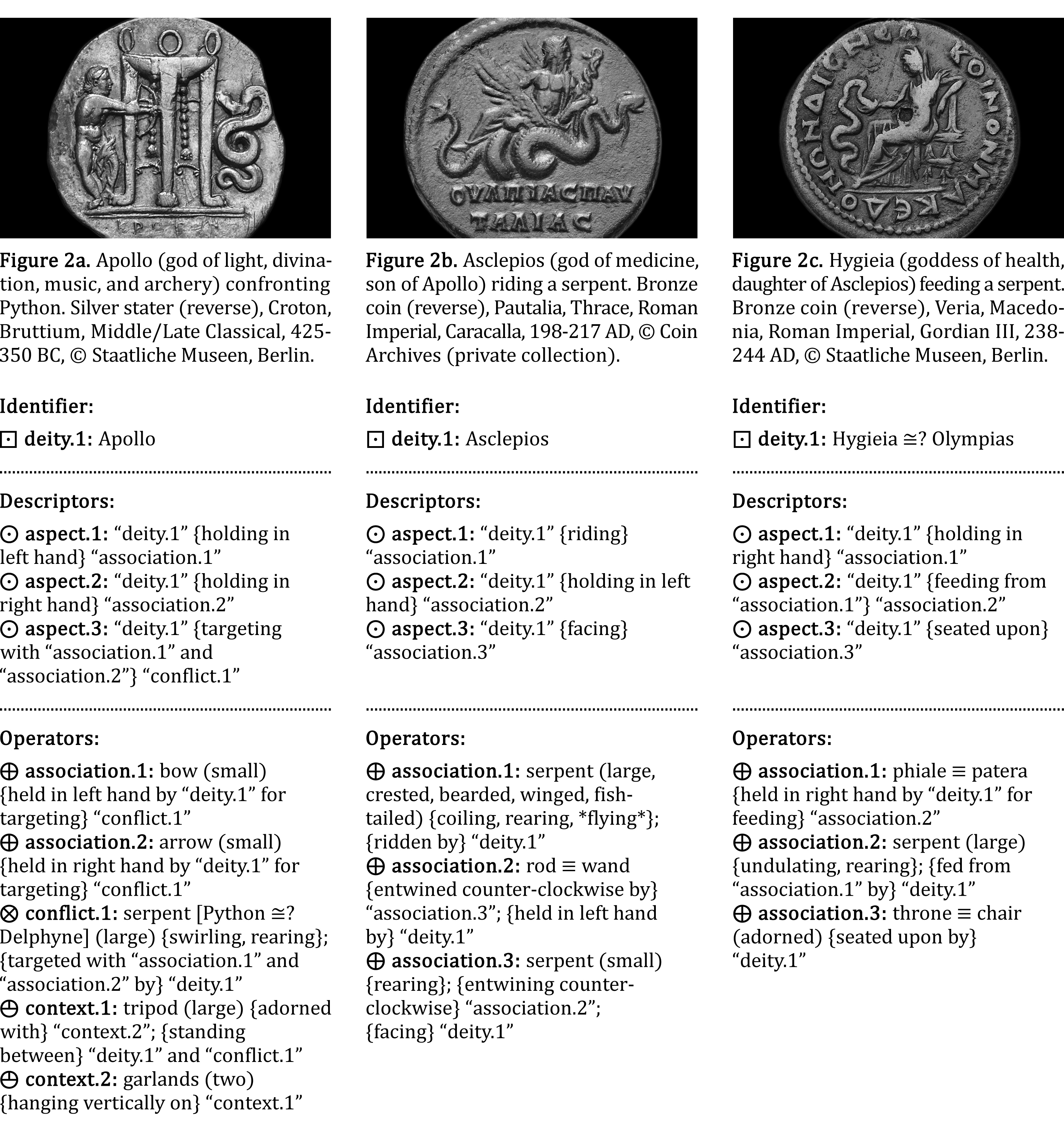1. Abstract
What are the best practical ways of building a specialized iconography database and developing meaningful metadata for a corpus of images selected by a common subject? While information studies offer theoretical foundations and abstract schemes, practice-based resources development such as that described in this paper provides practical outcomes and key solutions.
Serpentarium Mundi (www.serpentarium.org) is a specialized digital iconography compendium dedicated to snakes/serpents and their manifold derivatives (e.g. dragons). It catalogues representations of real and imaginary ophiomorphs in the visual arts of Old World civilizations from 3000 BC to 650 AD. The compendium’s compositional framework uses the structural metaphor of traditional (print) media and consists of volumes (e.g. Coins), chapters (e.g. Deities), and articles (e.g. Agathodaemon). A minimalist approach is currently adopted: the compendium articles focus on iconographical (visual) records with the textual component limited to brief descriptions. The advanced version will include three common components: (1) a complete catalogue of the subjects’ iconographic types, consisting of figures supplemented by detailed descriptions and references; (2) observations on the subject’s reception in antiquity and a survey of related primary sources; and (3) the subject’s interpretation in broader cultural and historical contexts and a survey of the secondary literature.
The project website serves as a limited-functionality test prototype of the SOLID (Specialized On-Line Iconography Database) digital framework. The project is a collaborative, multidisciplinary enterprise, enthusiastically sharing the values of the open data movement. It employs expertise in the fields of classics, religious studies, comparative mythology, ethnozoology, art history, and computer science. Serpentarium Mundi draws extensively upon the successes and failures of major online iconography projects, such as Iconclass, Digital LIMC, and The Warburg Institute Iconographic Database.
The presentation will inform regarding the current state of the relevant scholarship and will address several project aspects and outcomes: (1) goals established (e.g. becoming the ultimate ophidian iconography resource); (2) challenges encountered (e.g. current lack of institutional support and funding; project curator’s limited technical expertise); (3) lessons learned (e.g. need to anticipate the unforeseen complexities of the evolving image classification taxonomies); and (4) discoveries made (e.g. positive identification of the nebulous iconographic subject). The following technical and organizational features will be discussed: information architecture, functionality, content selection, visual presentation, analytics, and collaboration.
The snake/serpent is a ubiquitous and intrinsically polysemantic artistic subject. The notion of “serpent” is the product of the cultural reception of the snake as a peculiar biological species, followed by its creative modification. This transformation is usually accompanied by the complex processes of intra- and inter-cultural interpretation, appropriation, adaptation, preservation, and dissemination. Snakes and serpents play prominent roles in mythology, religion, and art and are important subjects in cultural and cross-cultural (comparative) studies (Mundkur 1983). A substantial body of literature is dedicated to the mythology, symbolism, and iconography of the serpent/dragon in diverse cultural contexts - from the Greco-Roman World and Egypt to India and China, and from the Biblical tradition to early Islam (Charlesworth 2010, Ogden 2013).
The theoretical framework of the project is informed by the pertinent discussion on iconography/iconology (Mitchell 1986; van Straten 1994), visual semiotics (Lorenz 2016), metadata (Baca 2016), and knowledge organization (Hjørland 2008). The modified methodological scheme iconography (analytic, proto-iconic stage: pictographic inventorization) → iconology (synthetic, proper-iconic stage: descriptive identification) → iconosophy (hermeneutic, meta-iconic stage: contextual interpretation) will be introduced (cf. Panofsky 1939).
The project is inspired by the pioneering works on the ontology-based iconography conducted at the Warburg Institute (Gartner 2019) and the “Sofia School” (Pavlova-Draganova, Paneva-Marinova, and Pavlov 2011). In this particular context, ontology is understood as a knowledge-organizing process. It provides a conceptual model for describing a system (within a certain domain of discourse) consisting of types of entities, properties, and relations. The primary purpose of ontology is to limit complexity and help to convert data into information and knowledge. The use of ontologies in knowledge-based systems facilitates effective communication between various groups and domains and thus provides the foundation for knowledge dissemination and interdisciplinary collaboration.
In this project, classification is the crucial component of the knowledge-organizing process (Szostak 2014). To facilitate the development of classification taxonomies, a novel analytical device, the three-faceted formal semantic indicator (identifier-descriptor-operator) was developed (Figure 1). The device is intended to contribute to future ontology-based iconography research as an instrument facilitating the classification, contextualization, and interpretation of images (Shatford 1986). It could also be potentially incorporated as a functional component into computational procedures involving the machine-readable ontologies (Allemang and Hendler 2011).
 Figure 1: Formal semantic indicator and relevant ontological/iconographical categories.
Figure 1: Formal semantic indicator and relevant ontological/iconographical categories.
The experimental application of formal semantic indicators for the classification of numismatic iconographic types will be illustrated on the example of one divine lineage, focusing on three successive generations of principal deities (Figure 2).
 Figure 2: Depictions of deities interacting with serpents described with the formal semantic indicators.
Figure 2: Depictions of deities interacting with serpents described with the formal semantic indicators.
The presentation intends to initiate discussion, solicit feedback, and obtain expert advice from specialists in the fields of database development, cross-domain metadata, semantic web, content/network analysis, data visualization, geographic information systems, and digital museology.
Bibliography
Allemang, Dean and James Hendler. (2011). Semantic Web for the Working Ontologist: Effective Modeling in RDFS and OWL, 2nd edition. Waltham: Morgan Kaufmann Publishers.
Baca, Murtha. (2016). Introduction to Metadata, 3rd edition. Los Angeles: The Getty Research Institute.
Charlesworth, James H. (2010). The Good and Evil Serpent: How a Universal Symbol Became Christianized. New Haven: Yale University Press.
Gartner, Richard. (2019). Towards an Ontology-Based Iconography. Digital Scholarship in the Humanities, fqz009, https://doi.org/10.1093/llc/fqz009 (Published: 11 February 2019).
Hjørland, Birger. (2008). What is Knowledge Organization (KO)? Knowledge Organization, Volume 35, Issue 2-3, 2008, pp. 86-101.
Lorenz, Katharina. (2016). Ancient Mythological Images and Their Interpretation: An Introduction to Iconology, Semiotics, and Image Studies in Classical Art History. Cambridge: Cambridge University Press.
Mitchell, W.J.T. (1986). Iconology: Image, Text, Ideology. Chicago: The University of Chicago Press.
Mundkur, Balaji. (1983). The Cult of the Serpent: An Interdisciplinary Survey of Its Manifestations and Origins. Albany: State University of New York Press.
Ogden, Daniel. (2013). Drakon: Dragon Myth and Serpent Cult in the Greek and Roman Worlds. Oxford: Oxford University Press.
Panofsky, Erwin. (1939). Studies in Iconology: Humanistic Themes in the Art of the Renaissance. Oxford: Oxford University Press.
Pavlova-Draganova, Lilia, Desislava Paneva-Marinova, and Radoslav Pavlov. (2011). Ontological Presentation of East-Christian Iconographical Art Domain. Serdica Journal of Computing, Volume 5, Number 2, 2011, pp. 101-114.
Shatford, Sara. (1986). Analyzing the Subject of a Picture: A Theoretical Approach. Cataloging & Classification Quarterly, Volume 6, Issue 3, 1984, pp. 39-62.
Szostak, Rick. (2014). Classifying the Humanities. Knowledge Organization, Volume 41, Issue 4, 2014, pp. 263-275.
van Straten, Roelof. (1994). An Introduction to Iconography: Symbols, Allusions and Meaning in the Visual Arts. London: Taylor & Francis.